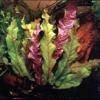Nymphaea maculata
Scientific name: Nymphaea maculata
Family: Nymphaecaceae
Maximum size reached under cultivation: 25 - 45 cm (9.84 - 17.72 inch)
014
Recommended pH range: 6.3 - 7.4
Recommended water hardness: 4 - 12°dGH (71.43 - 214.29ppm)
0°C 32°F30°C 86°F
Recommended temperature range: 20 - 30 °C (68 - 86°F)
Preferred propagation method: Bulb shoots
Native to: Africa
Growth rate: Normal
Recommended substrate: Fine gravel
Lighting requirements: Bright
Ideal placement in tank: Background
Common Name
African Tiger Lotus
Origin
Africa – Nymphaea maculata naturally occurs in tropical regions of West and Central Africa, particularly in calm or slow-moving waters like ponds, marshes, and streams.
Propagation
This species reproduces primarily through bulb shoots (daughter bulbs), which develop next to the mother plant. These can be gently separated and replanted once a root system has formed.
It is also possible to propagate this plant by seeds if the flowers reach the water surface and are pollinated – although this method is rarely used in aquariums due to space and time constraints.
Difficulty
Medium – although robust and adaptable, it requires trimming and careful placement due to its large size and rapid leaf development.
Short Description
Nymphaea maculata, commonly known as the African Tiger Lotus, is a striking aquatic plant known for its beautifully patterned, often reddish-green leaves and ability to produce surface flowers. It is best used as a background or centerpiece plant in large aquariums due to its spreading nature.
While it can be kept fully submerged for some time, it naturally develops floating leaves and may begin to flower if allowed to grow undisturbed. In smaller tanks, it’s best to remove flower stems before they reach the surface to encourage bushier, more compact growth.
This species thrives in a nutrient-rich substrate and appreciates strong lighting. CO2 and root fertilizers are not strictly necessary but will support better coloration and growth.
Due to its size and habit, it is also popular in outdoor ponds or open aquascapes where it has room to grow emersed and display its yellow or white blossoms.
FAQs
-
Can Nymphaea maculata be fully submerged in an aquarium?
Yes, it can be grown submerged, but over time it naturally tends to produce floating leaves. Regular trimming of vertical shoots can help keep the plant compact and submerged.
-
How can I prevent my Tiger Lotus from taking over the tank?
Remove long vertical leaves and flower stalks before they reach the surface. Keeping the plant pruned encourages denser, bushier growth and limits its spread.
-
What causes pale or transparent leaves on Nymphaea maculata?
This is usually a sign of nutrient deficiency, especially a lack of iron or root nutrients. Using root tabs or a nutrient-rich substrate can restore healthy leaf color.
-
Will it bloom underwater?
No, Nymphaea maculata needs to send flower stalks above the surface to bloom. It produces small yellow or white flowers when allowed to grow emersed or in open tanks or ponds.
-
Is this plant suitable for beginner aquarists?
Yes, it is hardy and tolerant of a wide range of water conditions. However, its fast growth and size require regular maintenance, making it more suitable for moderately experienced aquarists or those with larger tanks.

 Barclaya longifolia
Barclaya longifolia Nuphar japonicum
Nuphar japonicum Nymphaea lotus
Nymphaea lotus Nymphaea pubescens
Nymphaea pubescens Nymphaea zenkeri
Nymphaea zenkeri